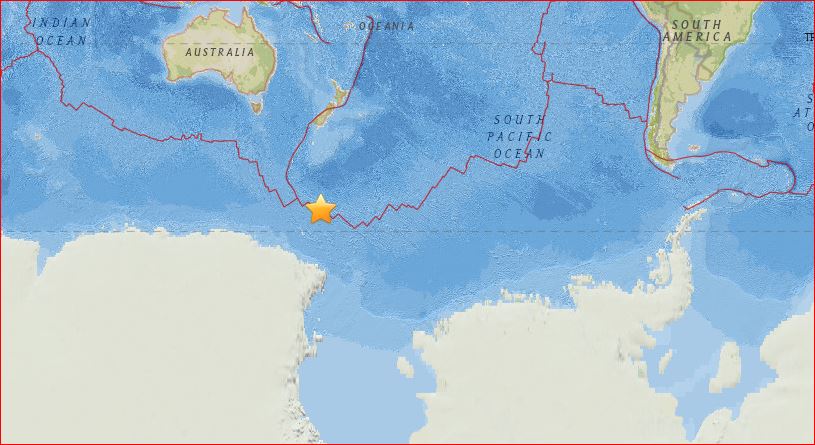A rare powerful magnitude 6.0 earthquake struck the region around the Balleny Islands, Antarctica on January 31, 2016.
The strong shallow earthquake was recorded at 5:39pm at a depth of 10 km 473km (294mi) NE of Young Island, Antarctica or 2475km (1538mi) S of Wellington, New Zealand.

According to the U.S. Geological Survey, earthquakes do occur occasionally in Antarctica, but not very often. There have been some big earthquakes–including one magnitude 8–in the Balleny Islands.
The boundary between the Scotia Plate and the Antarctic Plate just grazes the north tip of the Antarctic Peninsula (again, look “northwest” from the Pole toward South America). There is also a hint of a line of seismicity off the west coast of the Antarctic Peninsula and some activity in the Kerguelen Plateau (in the Indian Ocean “northeast” from the Pole). The Kerguelen Plateau is within the Antarctic Plate but it is not part of the Antarctic Continent. As with the interior area of all tectonic plates, earthquakes can and do occur in Antarctica, but they are much less frequent than quakes on the plate boundaries.
Another reason why there are fewer quakes located in Antarctica than within other plates such as Australia or North America is because smaller quakes are much more likely to go undetected in Antarctica because there are very few seismograph stations. There are only 19 operating seismograph stations (as of 2005 )in all of the continent of Antarctica, and only one of them, at the Amundsen-Scott South Pole Station, is in the interior of the continent. By comparison, there are 42 stations within the State of New Mexico. The closest seismograph station to the one at South Pole is 1350 km or about 840 miles. That’s a big area to hide little earthquakes in!
Finally, the interior of Antarctica has icequakes which, although they are much smaller, are perhaps more frequent than earthquakes. The icequakes are similar to earthquakes, but occur within the ice sheet itself instead of the land underneath the ice. Some of our polar observers have told us they can hear the icequakes and see them on the South Pole seismograph station, but they are much too small to be seen on enough stations to obtain a location.
Most probably linked to an underwater magma explosion at plate boundary.












Why ask the nuclear question without any facts?
Why ask the nuclear question without backing it up with some form of fact to add to the equation? Why do you question whether it was an earthquake or not? Being such a remote spot in a supposed no go zone who would you suggest is testing nukes in the area? Strange sounds were answered by the icequakes in your own article.
Please provide the missing parts.
Sorry I added the smiley after nuclear explosion… And underwater magma eruption. Is not icequakes as not on the continent but where plates collide… So probably magma eruption at plate boundaries. As it is very shallow 10 km (almost the depth of an fracking quake) I just emitted the ‘crazy’ hypothesis that it could have been triggered by a bomb (smiley is now added) as a joke. Natural quake of course.
I was once on Antarctica for scientific investigations and there are only army bases on the continent. But that was sarcastic. Sorry! MP
and there shall be earthquakes in divers places…
More End Time News At:
http://www.shininginthedark.com/?page_id=4526
[…] STRANGE SOUNDS REPORT HERE […]